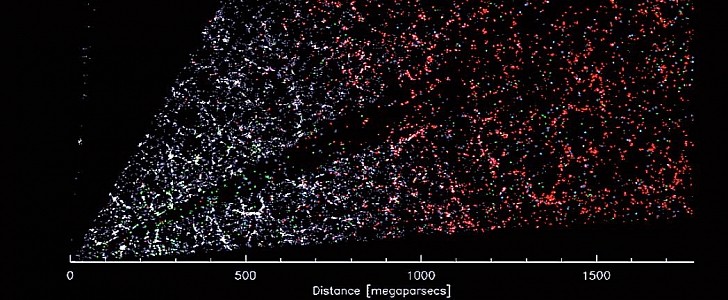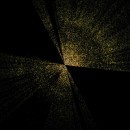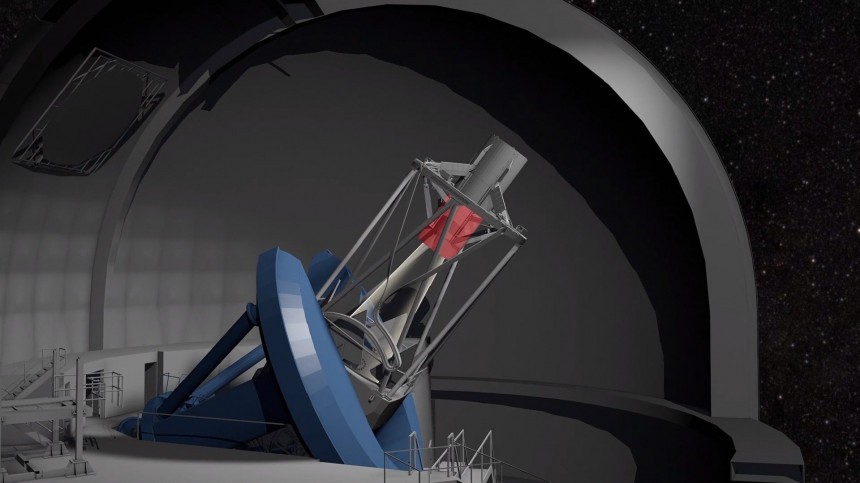Starting late last decade, the Mayall 4-meter telescope at Kitt Peak National Observatory in Arizona began running something called the Dark Energy Spectroscopic Instrument. DESI for short, it is tasked with creating a gigantic map of the Universe. And boy, did it already!
Containing a focal plate with 5,000 robotic positioners, 50-meter long (164 feet) optical fibers, broadband spectrographs, and detectors, the instrument is supposed to stay in operation for a total of five years.
During this time, it should be capable of creating a 3D map of the Universe going as far as 11 billion light years from our planet, and including 14,000 square degrees of the sky. In this map, DESI should include tens of millions of galaxies and quasars, marking the most ambitious such project ever conducted by the human race.
The thing, ran by the Department of Energy’s Lawrence Berkeley National Laboratory (Berkeley Lab), started being put together in 2015, but only saw first light (that’s how astronomers call the first time they use a telescope after construction) in 2019.
Then, the pandemic halted the project, and it was not until late 2020 that the hardware was up and running again. Its official survey mission kicked off exactly one year ago, and here’s what it has been up to until now.
At the beginning of 2022, just 10 percent of the time into its mission, DESI had already mapped out more galaxies than during all previous efforts, combined. In numbers we can all understand, that would be over 7.5 million galaxies, and over a million more are added each month. By 2026, people running DESI expect that number to grow to over 35 million galaxies, literally opening up the sky (and the past of the Universe, as looking at stars is like time travelling).
The stated goal behind coming up with such a large map is to measure the effects of dark energy on the expansion of the Universe. As some of you already know, our scientists believe that ever since the Big Bang, the Universe is continuously expanding.
That means galaxies and everything in them move away from one another, and the space between them gets filled with dark energy (the scientific phrase is no filled, but, believe it or not, "pop into existence").
Dark energy is supposed to be in some sense the opposite of gravity, pushing stuff away from one another. Mapping the Universe will give us a better understanding of this force, and might even put us on the right direction to answer a haunting question for astronomers: what will eventually happen with our Universe?
To map the galaxies for the task at hand, DESI breaks down the light from each one. Depending on how much that light is stretched toward the red end of the spectrum (called redshifting), it tells scientists how far it is from us, both in space and time.
It is light’s redshift that allowed DESI to compile the image you see as the main photo of this piece. Released back in January, it shows 5 billion light years of space, as seen in the direction of constellation Virgo and Bootes, with our planet in the lower left corner.
To give you a sense of scale, consider that every single colored dot in there is not a star, but a galaxy containing billions of Suns. A closer look reveals spots where galaxies cluster together, places where they’re absent, and filaments of light spreading out into the darkness.
DESI’s reach will however expand far past a better understanding of dark energy. Astronomers are already crunching the data to reveal more about the behavior of intermediate-mass black holes in small galaxies, but also of quasars (very bright galactic nuclei).
As DESI continues to look out into the Universe, the map you see here will grow exponentially, and even more difficult to comprehend with our human brains.
During this time, it should be capable of creating a 3D map of the Universe going as far as 11 billion light years from our planet, and including 14,000 square degrees of the sky. In this map, DESI should include tens of millions of galaxies and quasars, marking the most ambitious such project ever conducted by the human race.
The thing, ran by the Department of Energy’s Lawrence Berkeley National Laboratory (Berkeley Lab), started being put together in 2015, but only saw first light (that’s how astronomers call the first time they use a telescope after construction) in 2019.
Then, the pandemic halted the project, and it was not until late 2020 that the hardware was up and running again. Its official survey mission kicked off exactly one year ago, and here’s what it has been up to until now.
The stated goal behind coming up with such a large map is to measure the effects of dark energy on the expansion of the Universe. As some of you already know, our scientists believe that ever since the Big Bang, the Universe is continuously expanding.
That means galaxies and everything in them move away from one another, and the space between them gets filled with dark energy (the scientific phrase is no filled, but, believe it or not, "pop into existence").
Dark energy is supposed to be in some sense the opposite of gravity, pushing stuff away from one another. Mapping the Universe will give us a better understanding of this force, and might even put us on the right direction to answer a haunting question for astronomers: what will eventually happen with our Universe?
It is light’s redshift that allowed DESI to compile the image you see as the main photo of this piece. Released back in January, it shows 5 billion light years of space, as seen in the direction of constellation Virgo and Bootes, with our planet in the lower left corner.
To give you a sense of scale, consider that every single colored dot in there is not a star, but a galaxy containing billions of Suns. A closer look reveals spots where galaxies cluster together, places where they’re absent, and filaments of light spreading out into the darkness.
DESI’s reach will however expand far past a better understanding of dark energy. Astronomers are already crunching the data to reveal more about the behavior of intermediate-mass black holes in small galaxies, but also of quasars (very bright galactic nuclei).
As DESI continues to look out into the Universe, the map you see here will grow exponentially, and even more difficult to comprehend with our human brains.








